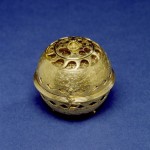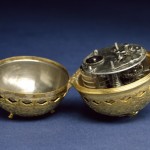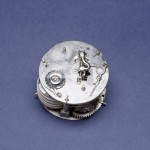 Most readers of Channel 37 have probably read the stories of Jules Verne, but how many of you know that some of his most memorable stories and characters were inspired by a real person? That person was Felix Nadar, who has been described as “one of the most curious Parisian characters from the nineteenth century and … the last survivor of the romantic Bohemians” (Ben Mackworth-Praed, Aviation: the Pioneer Years, 76). Nadar (that was his stage name) started out as a caricaturist for an illustrated magazine before launching two magazines of his own, and eventually drifting into photography, which was then all the rage in Paris. A daredevil at heart, he took the world’s first aerial photographs, from the gondola of a balloon, and there he discovered his other great love — buoyant flight. The combination proved to be ready-made for some steampunk-era adventuring.
Most readers of Channel 37 have probably read the stories of Jules Verne, but how many of you know that some of his most memorable stories and characters were inspired by a real person? That person was Felix Nadar, who has been described as “one of the most curious Parisian characters from the nineteenth century and … the last survivor of the romantic Bohemians” (Ben Mackworth-Praed, Aviation: the Pioneer Years, 76). Nadar (that was his stage name) started out as a caricaturist for an illustrated magazine before launching two magazines of his own, and eventually drifting into photography, which was then all the rage in Paris. A daredevil at heart, he took the world’s first aerial photographs, from the gondola of a balloon, and there he discovered his other great love — buoyant flight. The combination proved to be ready-made for some steampunk-era adventuring.
 Never one to do anything halfway, in 1863 Nadar — inspired not only by his balloon flights but by correspondence with some of the era’s aviation pioneers and the fledgeling author Jules Verne — undertook a multitude of aviation-related activities. He published the Manifesto of Aerial Auto-Locomotion calling for research into winged flight, began publishing the magazine L’Aeronaut, and later founded “The Society for the Encouragement of Aerial Locomotion by Means of Heavier than Air Machines,” with himself as President and Verne as secretary. The society served as a model for the Baltimore Gun Club, the Weldon Institute, and all the other societies that tend to appear at the beginning of Verne’s stories.
Never one to do anything halfway, in 1863 Nadar — inspired not only by his balloon flights but by correspondence with some of the era’s aviation pioneers and the fledgeling author Jules Verne — undertook a multitude of aviation-related activities. He published the Manifesto of Aerial Auto-Locomotion calling for research into winged flight, began publishing the magazine L’Aeronaut, and later founded “The Society for the Encouragement of Aerial Locomotion by Means of Heavier than Air Machines,” with himself as President and Verne as secretary. The society served as a model for the Baltimore Gun Club, the Weldon Institute, and all the other societies that tend to appear at the beginning of Verne’s stories.
Why the interest in heaver-than-air flight after becoming so enamored of balloons? The answer can be found in a misadventure that led to the publication of Verne’s first novel. That same year, 1863, Nadar constructed a 200,000 cubic-foot balloon, Le Géant (“The Giant”) — the largest gas balloon constructed up to that time. It was large enough to support a unique gondola underneath:
“The car had two stories, and was, in fact, a model of a cottage in wicker-work, 8 feet in height by 13 feet in length, containing a small printing-office, a photographic department, a refreshment-room, a lavatory, &c.” (Encyclopedia Britannica, 1902 edition)
The balloon set off with Nadar, his wife, and seven other passengers for a grand flight across Europe that ended in farce 17 hours later. While attempting to land in Hanover, the balloon was caught in strong winds and was dragged along the ground for over seven miles, with everyone aboard bumping around the house sustaining bruises and broken bones. Undaunted, however, Nadar shipped the gondola-house — which was rather conspicuously out of plumb after its travails — back to England, where it was exhibited at the Crystal Palace for a year and generated much enthusiasm for flying among the people who came to see it.
 The enthusiasm spread to Jules Verne, who wrote Five Weeks in a Balloon, which included all the elements for which his later adventure stories would be famous. A scene from the novel in which the balloon was dragged across the landscape for miles after snaring an enraged elephant was no doubt inspired by the wild ride of Le Géant!
The enthusiasm spread to Jules Verne, who wrote Five Weeks in a Balloon, which included all the elements for which his later adventure stories would be famous. A scene from the novel in which the balloon was dragged across the landscape for miles after snaring an enraged elephant was no doubt inspired by the wild ride of Le Géant!
Although Nadar swore off balloons after his memorable mishap, he continued to frequent the Paris flying scene, keeping his society and magazine going long enough to bring together some of the pioneers who would lay the groundwork for the Wright Brothers just a few decades later. Returning to photography, Nadar took iconic portraits of many of the day’s noted aviators. He lived long enough to see the dream of heavier-than-air flight come true, dying in 1910 at the age of 89.
But that’s not the end of his influence on Verne. He was also the inspiration for the French adventurer Michel Ardan, who volunteers to fly in a projective to the moon in Verne’s iconic masterpiece, From the Earth to the Moon. How fitting that Nadar, the daring balloon pilot and promoter of winged flight, should also symbolically embark on what would soon be mankind’s next great adventure!









